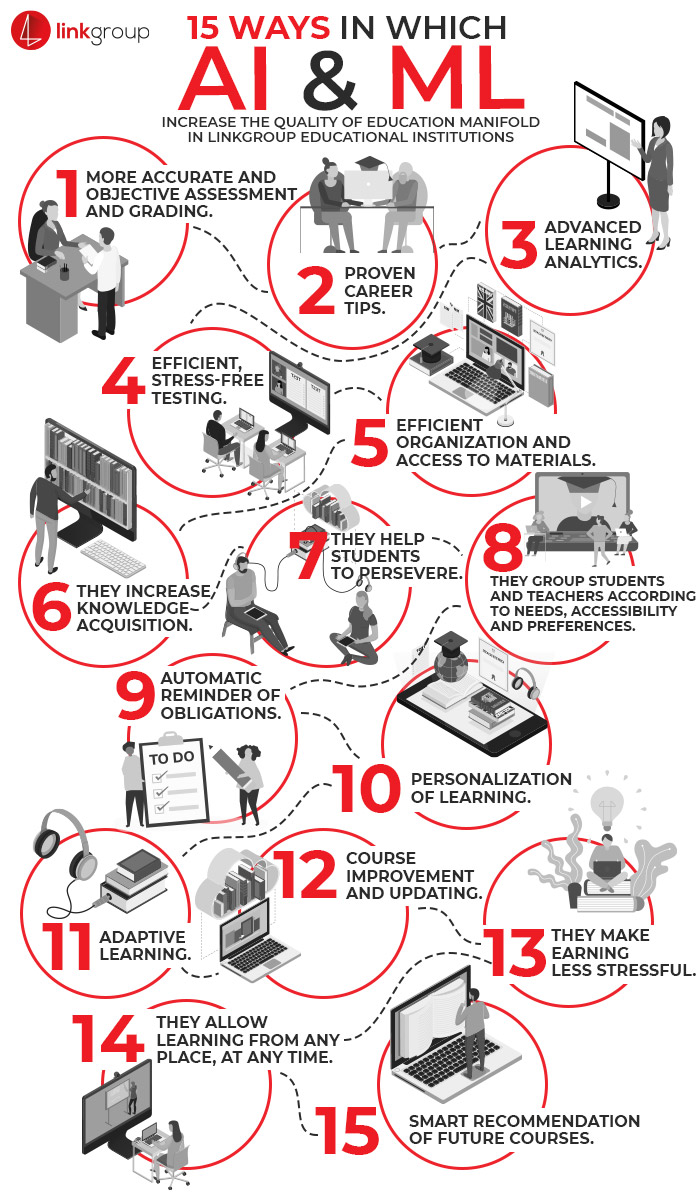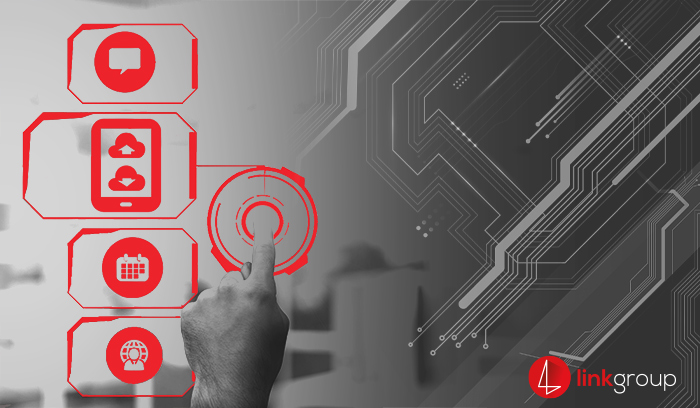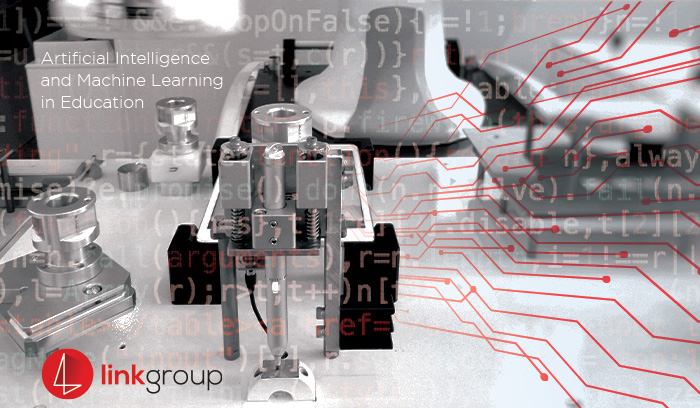The best educational institutions in the world have realized that AI and ML are not just the future of education, but its present as well. This is why they decided to provide an interactive and advanced educational experience to their students through the use of such technology. Hence, it is not surprising that 65% of the universities in the USA support AI- and ML-assisted learning.
LINK DL platform – a perfect synergy of AI and dedicated teachers
From the very beginning, LINKgroup has been a leader in the implementation of the latest achievements and standards in the field of education. This is why our company has been recognized as a leader in the efficient application of technological, pedagogical and adult education-related practices in education, both in Serbia and the region.
The latest AI and ML achievements have been successfully integrated into our DL platform – a state-of-the-art distance learning tool. However, the main force that drives changes in all LINKgroup institutions is people, and technology is only there to help them achieve the best results.
Hence the perfect synergy between our dedicated teachers and the latest AI solutions is a guarantee that learners who enroll at any institution within the LINKgroup system will receive education of the highest quality.
15 ways in which AI and ML increase the quality of education manifold in LINKgroup educational institutions
 1. More accurate and objective assessment and grading. AI and ML ensure an improved assessment and grading process. The combination of these algorithms and human insight of experienced teachers guarantees that student knowledge will be assessed objectively and accurately, and that the ensuing grade will represent the fairest possible expression of their knowledge.
1. More accurate and objective assessment and grading. AI and ML ensure an improved assessment and grading process. The combination of these algorithms and human insight of experienced teachers guarantees that student knowledge will be assessed objectively and accurately, and that the ensuing grade will represent the fairest possible expression of their knowledge.
2. Proven career tips. Based on various user data, such as test results, strengths and weaknesses, interests and inclinations, ML and AI can also suggest the best career for a student, i.e. areas for which he/she shows most potential. In order to make such professional assessment as thorough and accurate as possible, the professional assistance of the
Career Assistance Counselor is necessary. The synergy between technology-assisted data analysis and human insight and understanding guarantees the best professional assessment for each student.
3. Advanced learning analytics. ML and AI are able to provide large amounts of data that would be very difficult to access manually. Moreover, this system can establish connections and find patterns between seemingly unrelated data, thus providing the teacher with new insights that improve learning.
4. Efficient, stress-free testing. Thanks to AI and ML, testing becomes more efficient, and less stressful at the same time. Students can test their knowledge after each unit, and the results will immediately show them the extent to which they've mastered the content, as well as potential weak spots that require additional effort. In addition, teachers receive accurate feedback on the advancement of their students, as well as problematic areas they struggle with, based on which they can adapt their approach and help students to become even more efficient.
5. Efficient organization and access to materials. The material divided into micro-units allows students to adopt smaller amounts of information within short time periods. This method of learning has proved to be extremely efficient and period-appropriate. In addition, the automation of numerous tasks and their execution by AI and ML allow students and teachers to focus all their energy into learning and teaching. This way, knowledge acquisition becomes even more efficient.
6. They increase knowledge acquisition. This method of learning is more efficient when it comes to content acquisition. Divided into units, adapted to a student's preferred style of learning and available time, with many interactive examples and functions, this method allows students to better master the content, and retain the knowledge longer. The combination of AI and the
Architecture of Knowledge, a unique patent of the LINKgroup company for quick and efficient learning, brings the best educational results.
7. They help students to persevere. ML and AI provide important insights into the performance and advancement of each student. This way, they allow teachers to quickly recognize if a student has difficulties to master the content, fails to perform his/her obligations regularly, or lacks motivation. Thanks to all these data, they can provide assistance, encouragement, even the
Learning Assistance Counselor. Therefore, each student is encouraged to finish school, and offered support, inspiration and encouragement at every step to successfully fulfill their obligations.
8. They group students and teachers according to needs, accessibility and preferences. Based on preferences, learning style or educational goals, AI and ML can suggest the formation of student or teacher groups. In other words, they bring together people who can work well as a team. This way, students are always surrounded by people who suit them and who can help them. They can exchange materials, ideas, or work together on projects, and many have met their future friends and colleagues with whom they continued their professional journey long after they finished school.
9. Automatic reminder of obligations. DL enables the automation of both student and teacher obligations. This way, everyone is automatically reminded of scheduled meetings, lectures, and upcoming obligations in a timely manner. The risk of forgetting one's schedule is practically non-existent, which allows students to fully commit themselves to studying.
10. Personalization of learning. Thanks to complex algorithms that provide important information about the way in which each student learns, teachers are able to adapt their teaching style and to provide additional support to each student if necessary. This technology can also provide educational tools able to adapt to the unique learning style of each student. In addition, students can choose the pace and time of learning that suit them, as well as certain elective courses. Thus they become active participants in the education process, instead of passive recipients of knowledge.
11. Adaptive learning. The learning process is adapted to the student's performance, so those who have difficulties are given assistance and tools to overcome them, whereas those who perform well are provided with additional challenges to advance even further.
12. Course improvement and updating. So as to ensure the highest quality of each course, we need to adapt it to student needs, as well as to provide current and relevant knowledge of the given area. How does this work in practice? If a significant number of students give an incorrect answer to the same question, the course is modified in such a way as to help future students reach the correct answer. This way, any potential shortcomings of the course are promptly corrected, thus ensuring that each student receives the same quality of knowledge. Some of the most popular websites for online learning are beginning to switch to this method of learning, and thanks to LINK DL platforms, our students are among the first in the world to enjoy its benefits. Moreover, if there are new developments in the given area, or the appearance of new tools and software, the course is updated immediately, providing current and relevant knowledge.
13. They make learning less stressful. An important part of the education process everywhere is certainly trial and error learning. Students simply have to try and implement their own solutions, suffer a possible failure, and learn from it to try again. However, many find the idea of making a mistake in the presence of a teacher or their classmates stressful. Thanks to AI and ML, students can answer questions without fear of errors. Whenever they give an incorrect answer, the system will signal the mistake and point them to the areas they need to read to give the correct answer. This way, students can test themselves without fear of judgment of their environment, and they will always be able to correct themselves.
14. They allow learning from any place, at any time. Thanks to the fact that AI and ML are integrated into the DL platform, students are able to learn from any place, at any time. All they need is Internet access. This makes the DL platform perfectly adapted to the lifestyle of today's students, their habits and the exciting digital age we live in.
15. Smart recommendation of future courses. Based on the students’ results, the areas in which they perform well or those they struggled with, and their preferences and inclinations, ML and AI suggest future courses that may suit them and complement their knowledge in the best possible way. Of course, the students are in no way obligated to accept the recommended courses, but this function greatly facilitates student orientation.
Machine learning and artificial intelligence will complement blockchain-based development projects recently launched by LINKgroup

 1. More accurate and objective assessment and grading. AI and ML ensure an improved assessment and grading process. The combination of these algorithms and human insight of experienced teachers guarantees that student knowledge will be assessed objectively and accurately, and that the ensuing grade will represent the fairest possible expression of their knowledge.
1. More accurate and objective assessment and grading. AI and ML ensure an improved assessment and grading process. The combination of these algorithms and human insight of experienced teachers guarantees that student knowledge will be assessed objectively and accurately, and that the ensuing grade will represent the fairest possible expression of their knowledge.


Leave a comment